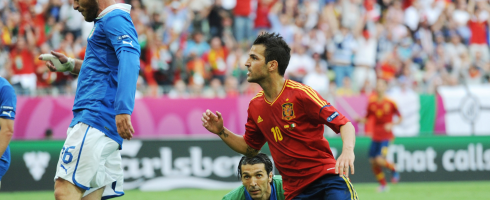It may have been billed as the Clash of the Titans but for many, Group C’s opening match at Euro 2012 was Spain’s chance to finally defeat an old foe who no longer seemed invincible.
Yet despite spending the last 20 minutes defending, it was the Italians who walked out with their heads held high, as the critics aimed their venom at the Spaniards. Playing a horizontal game that demonstrated their obsession with possession, Vicente del Bosque’s side struggled to find the vertical edge needed to make use of all their time on the ball.
Many criticised the Coach’s decision to opt for six midfielders and no traditional No 9 but when considering the fact Italy were playing with a 3-5-2 formation that had a midfielder at the back, one can understand his decision. He wanted to make life difficult for Italy’s back three, leaving them with no reference point to mark and overwhelming them with the movement of his front three midfielders.
The problem was Italy were tactically perfect, especially in the first half. Playing with the arrogance of a footballing giant, they opted for their changed formation so as to exploit the spaces on the wing left behind by a narrow Spanish side. With their opponents focusing attacks through the middle, the Azzurri hoped their three centre-backs would be able to block, intercept and clear any Spanish chances.
As well as playing a tactical shape that would stifle Spain, the Italians applied pressure, pressed high up the pitch and positioned themselves in a way that consistently disrupted their opponent’s passing game. La Furia Roja needed a player adept at playing laterally but their attempts were quashed by a certain Antonio Cassano who positioned himself intelligently when out of possession to ensure Spain struggled both vertically and especially laterally.
With few lateral passes and no vertical penetration, Spain struggled to finish off the many chances they created, insisting on their attempts to pass the ball into the back of the net. Only Andres Iniesta seemed to understand the problem with his side’s game and attempted to resolve the situation by pulling defenders away, creating spaces through the middle and dribbling past the Italians to strike – acting as a vertical point for his team.
In the second half, the Spaniards played in more advanced positions with Xavi Hernandez especially pushing further up the pitch. Sergio Busquets began to deliver more forward passes whilst Xabi Alonso initiated his passes further up the field to allow for a more direct approach. As a result of all the changes, Spain were able to equalise three minutes after conceding a goal.
Jesus Navas was introduced in a bid to give the side more width and he stretched the solid Italian defence to create more holes down the middle. However, it was only when Fernando Torres was introduced did Spain really begin to trouble the opposition as he exposed the flaws of makeshift centre-back Daniele De Rossi’s defensive game, namely his lack of pace, and finally offered his horizontal side the player needed to create solid scoring opportunities through consistent vertical play.
Whilst Barcelona are the team everyone wishes to emulate, without a Dani Alves who makes his fast runs from deep positions and a Lionel Messi to dribble past every defender available, playing six midfielders and no actual striker is bound to result in players making one too many passes as they struggle to finish off their chances. Against Italy, Spain valued their possession game too much when they ought to have been gambling on vertical passes, even if it led to the loss of possession.

